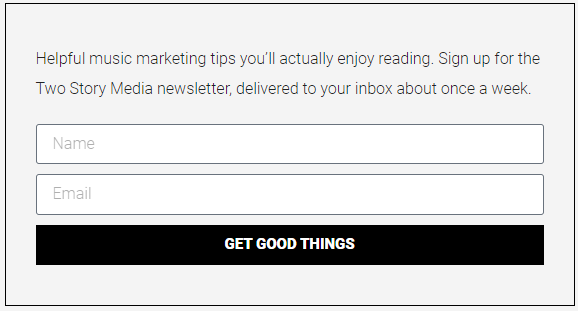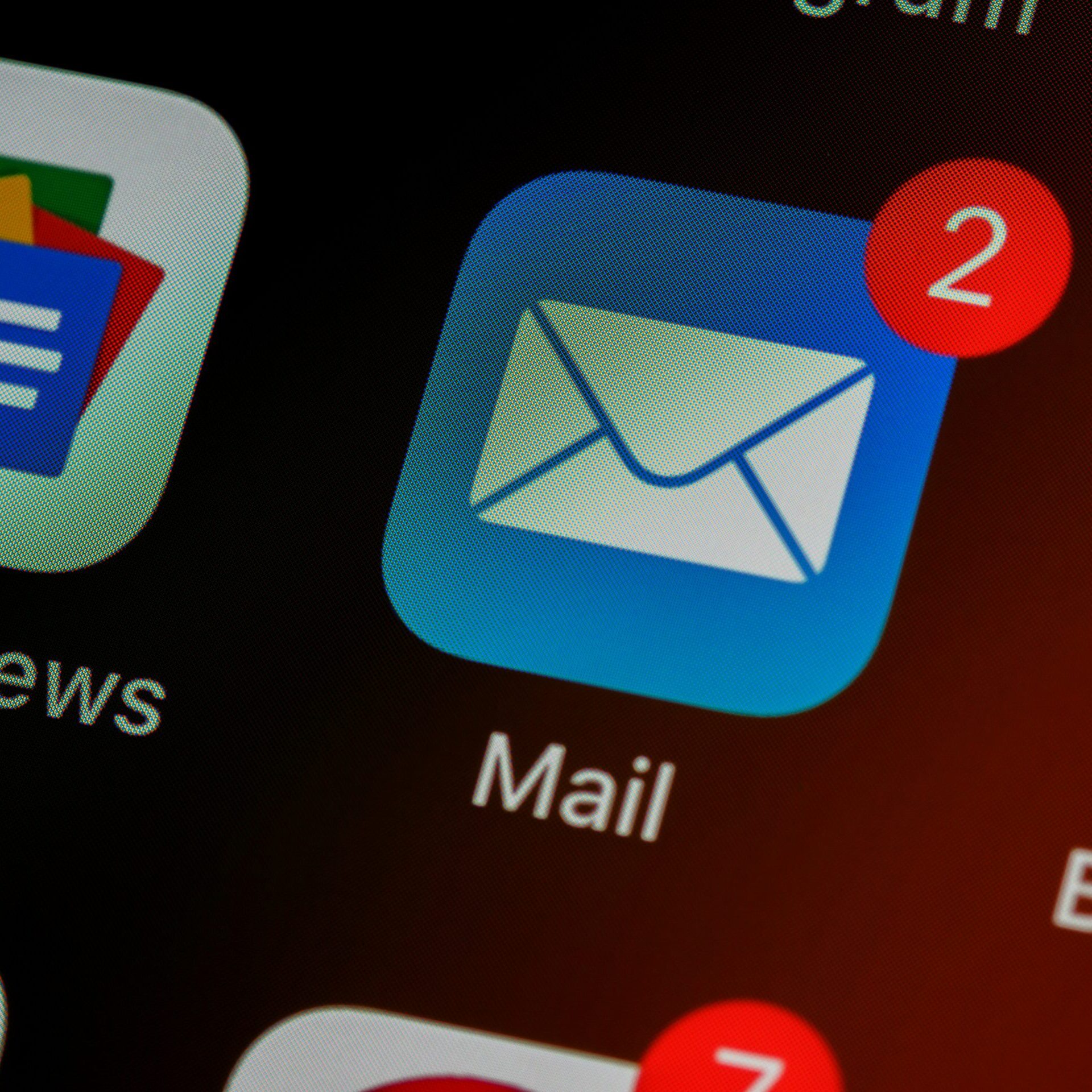Despite everyone saying that email remains an underrated and underappreciated marketing channel, the fact is that email remains severely underrated. This underrated streak is almost as impressive as Cal Ripken Jr. starting two thousand one hundred and thirty-one consecutive major league baseball games.
Email marketing wins the Iron Man Award for underrated marketing tactics for musicians.
A quick review of my email subscriptions reveals a handful of newsletters from my favorite authors, an eclectic assortment of retailers, and only two artists. One friend from college and, at one point in the past, my favorite musician convinced me to sign up for email updates, and now I’m instantly alerted every time Andrew McMahon drops an album, goes on tour, sells new merch, or headlines an exclusive four-day cruise to the Bahamas.
But Andrew’s the GOAT.
When I think of how I interact with most musicians, it’s in a visual medium like YouTube or TikTok. With apologies to the poets out there, there’s no music in the written word. If I like an artist’s music, it logically follows that I want to hear it the majority of the time I interact with them.
All of that to say, it’s understandable that email gets overlooked despite being one of the most effective ways to build relationships and grow your business.
If this is the year you finally decide to join the ranks of email marketer, here are some of the best steps to growing your list.
What is Email Marketing?
You may have never considered starting an email list, so let’s take a quick step back and talk about “what is email marketing”.
Email marketing is using your collection of email addresses to grow engagement with your subscribers and promote products and services.
Your email list is the lifeblood of email marketing. As one of the truly owned marketing channels, growing this list will increase your ability to connect with your fanbase directly.
Why is it worth Creating or Growing an Email List in 2024?
As we mentioned at the top of the article, email is admittedly not the flashiest channel.
It lacks the stimulation and excitement of social media. You are more likely to see articles about how to grow on TikTok or YouTube due to the engagement and growth of those channels than articles on email marketing.
But while you’re working on the flashy and exciting, don’t forget about the tried and true.
Consider some of the data in HubSpot’s Ultimate List of Email Marketing Stats for 2023 that might blow your mind if you’ve never truly thought about email marketing. Here are a few of the eye catching highlights they share:
- There are 4 billion daily email users
- 37% of brands are increasing their email budget
- 77% of marketers have seen an increase in email engagement over the last 12 months
- Email marketing revenue is expected to grow to $17.9 billion by 2027
In other words, you haven’t missed the boat.
The statistics around email marketing are both incredibly large in their current state and increasing.
If you haven’t started, now is the perfect time.
Best Email Marketing Companies to Consider
If you’re just getting started, there are a number of companies that will help set you up for success. They all have slightly different price points and features that you could find appealing depending on your circumstances. For a more detailed exploration of the pros and cons of services, you can check out our post on our favorite email marketing providers for musicians.
For a quick overview, here are three of the top providers to check out:
Each platform is intuitive and easy to use and allows you to execute everything you need for a successful email marketing program.
Define What You’re Offering
Now, let’s pivot from the operational nuts and bolts of how to set your email list to what will perform well, leading to better communities and consistent growth.
The key to growing an email list is to meet your subscribers’ expectations.
Whether they’ve bought a product from you before or opted in for some other reason, you need to ensure your emails align with the conditional agreement of the relationship.
Once again, reviewing the lists I’m on as a consumer, I’m looking for different things.
The Daily Stoic is a short blurb I get daily with a small dose of ancient wisdom from philosophers like Seneca, Epictetus, and Marcus Aurelius. I don’t always read it, but when I do, I appreciate the practical wisdom of how to live well in a chaotic world.
Because I enjoy the blurb and find it valuable, I’m willing to put up with the promotional piece at the end, where the author advertises his products and services.
On the other hand, Wayfair emails me two to three times a day about sales they have going on and with friendly nudges about products I’ve viewed previously. I signed up for this when I first bought my house and have remained subscribed out of a certain level of apathy and irrational hope that one day the full-size NFL Blitz arcade game will be 80% on sale.
As long as you are upfront about the value subscribing to your newsletter or email messaging will provide and you deliver on it, you have a lot of latitude in how you want to approach your email list. If the value is there, the promotional asks won’t be annoying.
Create a one-sentence elevator for your pitch that defines what it is and why people would enjoy it.
Follow through on your value proposition, and you’ll be able to grow your list with the right people over time.
Lean into Exclusivity
Whichever direction you go with your email marketing, we recommend leaning into making your list an exclusive club.
Your email list is a group of people who have told you they’re your most motivated fans.
They’ve given you more attention than anyone else and are the most motivated to support you and take actions you’re hoping fans will take.
Show them that you appreciate that and reward their behavior. Focus your efforts on the most engaged portion of your email list.
You would rather have a smaller list engaging in the ways you’re hoping for than grow your list faster with people who won’t engage and eventually unsubscribe anyway.
Especially if you’re using a service that charges you for the number of emails in your list, growing your list with unengaged subscribers will cost you money.
The best way to keep users engaged is to lean into exclusivity. What can a subscriber to your email list get that they won’t get if they follow you on social media.
Whether it’s offering exclusive content, early releases, or merch giveaways, you have a nearly limitless number of options available to you. Make your list an elite club with perks, and you offer an exclusivity people intrinsically crave.
Establish Email Capture Touch Points
Once you define the primary purpose of your email offering and the exclusive value it can provide, the next critical step in growing your list will be to establish your email capture points.
Namely, you must explicitly ask people for their email addresses to grow your list.

This is easiest if you have a website.
Using the Two Story Melody site as an example, we offer users multiple avenues to enter our email list.
We talk about our weekly newsletter, we offer free resources like our case study on how Jon and Tom got over 200k Spotify streams on their song “Spring,” and we have a call-to-action right in the middle of the homepage.
You don’t want to over do it, but it’s essential to have multiple, relevant, highly-visible points of email capture if you want to grow your list.
Leverage Segmentation
This may be counterintuitive, but not everyone in your email list should get every communication.
Going back to that Hubspot study, they found that, “segmented emails drive 30% more opens and 50% more clicks through than unsegmented ones.”
Selective segmentation is a simple yet underrated step of respecting your subscriber’s time and demonstrating that you care enough to filter out irrelevant communications and only give them what they’re most interested in.
You don’t need to go overboard, either. I would recommend starting with a few basics. Here are a few simple ways you can start segmenting your lists:
- By order history or purchase data
- Demographic data
- Engagement level
The most straightforward strategy to get started with this is to directly ask your subscribers what their preferences are with your email communication.
Using ourselves as an example again, if we’re launching a new course or service and know we’re going to have a series of emails about it, we always offer our subscribers the option to opt out of that series and save their inboxes.

Once you start segmenting, you can draw conclusions on which strategies work best for you. Over time, your plan can become more sophisticated if it’s proving valuable.
The primary benefit of an email list might be your total control over reaching everyone on your list. You don’t have to worry about a third-party platform suppressing your reach to incentivize the paid aspects of its program. But just because it’s your prerogative doesn’t mean you shouldn’t be judicious about how you employ that power.
If you haven’t been convinced yet of the powers of segmentation, in addition to all of the positive benefits, such as:
- Boosting open rates
- Improving conversion rates
- Improving engagement
One of the most significant ways this will help you is by decreasing your amount of unsubscribers.
Losing fewer subscribers along the way will help you build your base gradually over time and keep you on the slow incline. It will be challenging to get ahead if you lose subscribers as quickly as you can gain them. Segmentation is a great way to improve engagement and keep people on your journey.
Final Thoughts
Don’t let this be another year you sleep on email marketing.
It’s perpetually underrated but still the most stable aspect of your marketing platforms. You never have to worry about a billionaire buying your email list and making wild changes that shake up the status quo. I’m looking at you Twitter, er, X, whatever you are now.
Following the principles outlined here, you can set yourself up for success and start growing your list.
If you’re looking for the next step, here are five more email marketing tips you can use.








